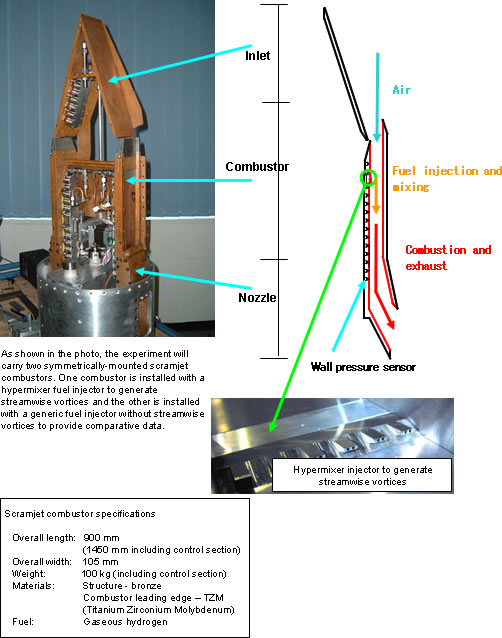Commissioning of Scramjet Combustor Flight Experiment
Japan Aerospace Exploration Agency (JAXA)
The Japan Aerospace Exploration Agency (JAXA) has undertaken research into scramjet engines, which are one of the leading candidates for next-generation space transportation propulsion systems, since 1987. JAXA has developed a proprietary scramjet combustor and has commissioned Australia's University of Queensland to perform a flight experiment with the combustor on 28 March 2006 (until 31 March 2006, if required).
The aim of the experiment is to obtain experimental data in a real flight environment for a scramjet combustor with an advanced fuel injector (hypermixer injector to generate streamwise vortices) developed by JAXA. The data will be compared with the results of ground tests performed in the HIEST high-enthalpy shock tunnel facility. The scramjet combustor is mounted on the front of a small sounding rocket and accelerated to a speed close to Mach 8 for the experiment. During the experiment, which will last approximately six seconds, internal pressure data for the combustor is recorded.
This flight experiment will benefit the development of future space transportation systems as outlined in JAXA's long-term vision and provide a valuable contribution to ongoing aerospace vehicle development.
- Experiment Contractor
- The University of Queensland, Australia
- Experiment Location
- Woomera Test Range, Australia
- Experiment Date
- 28 March 2006 (until 31 March 2006, if required)
- Experiment Lead
- The University of Queensland, Australia
- Department in charge at JAXA
- Combined Propulsion Research Group, Institute of Aerospace Technology (IAT)
|
|
GLOSSARY
1. Scramjet Engine
A SCRamjet (Supersonic Combustion Ramjet) is an engine being researched for use in aircraft or future space transportation systems that operates at high speeds of approximately Mach 4 (4 times the speed of sound) or above.
While typical jet engines compress air with a multi-bladed rotating fan before it enters the combustion chamber, at flight speeds above about Mach 3, the air entering the engine can be compressed under its own momentum by simply narrowing the area of the flowpath in the downstream direction and a complicated construction is unnecessary. A jet engine for supersonic aircraft that uses this method is called a ramjet.
When a ramjet is operated at low speed, the flow through the engine slows to speeds below Mach 1 (subsonic flow). However, as the flight speed increases, the temperature and pressure of the incoming air into the combustor increases greatly and the engine performance suffers. To avoid this problem, at speeds above Mach 4, it is better to not slow down or compress the incoming air very much and perform combustion above the speed of sound (supersonic flow). Ramjets of this type are called Scramjets.
2. Hypermixer Fuel Injector to Generate Streamwise Vortices
In the combustor of a scramjet engine, it is necessary to perform mixing and burning of the fuel and air in an extremely short period of time (0.5 milliseconds = five 10,000ths of a second) while maintaining supersonic flow conditions.
Turbulent mixing of the fuel and air by the vortices present in the air is the most ideal mixing method, however, at supersonic flight speeds, the mixing of the fuel and air is reduced due to the strong suppression of vortex1 generation by the compressibility of the air flow. For this reason, the promotion of supersonic mixing and combustion is one of the key topics in scramjet research and it is being researched and developed around the world. One of the most promising methods for promoting supersonic mixing is the use of streamwise vortices (vortices that rotate in a direction parallel to the main flow direction). Research at JAXA has shown that the generation and control of vortex parameters (size, strength, distribution, rotational direction etc.) in supersonic flow is easier to accomplish with streamwise vortices than with transverse vortices. Based on the results of this research, JAXA has developed a hypermixer fuel injector that is able to efficiently and quickly generate large-scale strong streamwise vortices with little energy loss.
The HyShot-IV flight experiment will conduct an experiment under real flight conditions using a scramjet combustor installed with a wall-mounted hypermixer fuel injector to acquire combustor data in supersonic combustion mode.
1. In particular, transverse vortices (vortices that rotate in a direction perpendicular to the main flow direction).
For inquiries:
Public Affairs Section, General Services Division, Institute of Aerospace Technology,
Japan Aerospace Exploration Agency
7-44-1 Jindaiji Higashi-machi, Chofu-shi, Tokyo, 182-8522
TEL: +81-422-40-3958 FAX:+81-422-40-3281
Public Affairs Department, JAXA
Tel: +81-3-6266-6413 to 6416

